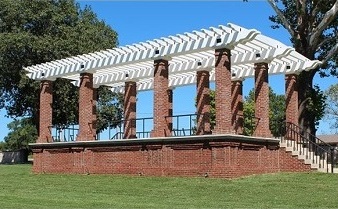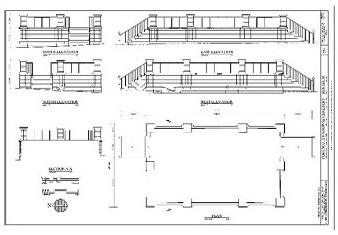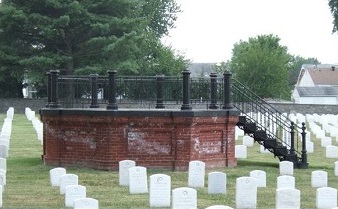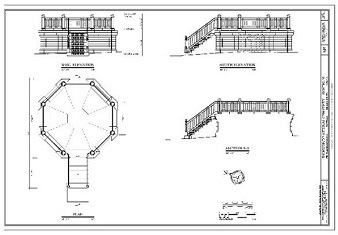Rostrums in National Cemeteries
The rostrums built in national cemeteries have served as speakers' stands during ceremonial occasions. The U.S. Army Quartermaster's Department developed these well-placed structures in response to the public's enthusiastic adoption of national cemeteries as places of memorial commemoration and patriotism in the aftermath of the Civil War. Two standard designs were the basis for all rostrums constructed in the nineteenth century. A major phase of new cemetery construction that began from the late 1930s and ended after World War II, included rostrums designed in a variety of regional, neoclassical and revival styles.
Of all the rostrums built between 1873 and 1956 in what are now NCA-managed properties, 37 are literally the platform used and often the centerpiece of Memorial Day events. Physically they reflect changing architectural trends, but they also reflect how we commemorate the dead. Rostrums are significant components of historic cemetery settings and a testament to commemorative traditions in the United States.
At a minimum, a rostrum is a structure composed of a raised base and roof. Fort Scott (KS) National Cemetery and Richmond (VA) National Cemetery represent the oldest examples. The rostrum at Fort Scott (below) has a rectangular footprint and a trellis roof. It was erected in 1882, substantially altered in 1931, and NCA rebuilt it to the original appearance in 2016. The octagonal rostrum at Richmond (below), 1888, has a brick base with cast-iron steps and railing; the metal roof was removed in the twentieth century. But a rostrum of the same design is extant at nearby Poplar Grove (VA) National Cemetery, a National Park Service site. Together these structures illustrate the original octagonal rostrum developed by the Quartermaster's Department in the 1870s.
Fort Scott National Cemetery


Richmond National Cemetery


Rostrums Documented for the Historic American Landscapes Survey
National cemetery rostrums were the subject of a research and documentation project completed for the Historic American Landscapes Survey (HALS) in 2014. The HALS collection is housed at the Library of Congress. The history reports, drawings, and photographs prepared about national cemetery rostrums are also available from the list below.
- Nationwide: National Cemeteries, Rostrums (HALS No. DC-47)
- Alabama: Mobile National Cemetery, Rostrum (HALS No. AL-1-B)
- Arkansas: Little Rock National Cemetery, Rostrum (HALS No. AR-2-C)
- California: Fort Rosecrans National Cemetery, Rostrum (HALS No. CA-7-B)
- California: Los Angeles National Cemetery, Rostrum (HABS No. CA-2709-C)
- California: San Francisco National Cemetery, Rostrum (HALS No. CA-1-B)
- Florida: Saint Augustine National Cemetery, Rostrum (HALS No. FL-3-B)
- Georgia: Marietta National Cemetery, Rostrum (HALS No. GA-1-B)
- Illinois: Alton National Cemetery, Rostrum (HALS No. IL-1-A)
- Illinois: Camp Butler National Cemetery, Rostrum (HALS No. IL-7-C)
- Illinois: Mound City National Cemetery, Rostrum (HALS No. IL-9-B)
- Indiana: New Albany National Cemetery, Rostrum (HALS No. IN-4-B)
- Kansas: Fort Scott National Cemetery, Rostrum (HALS No. KS-3-A)
- Kansas: Leavenworth National Cemetery, Rostrum (HALS No. KS-2-A)
- Kentucky: Cave Hill National Cemetery, Rostrum (HALS No. KY-8-B)
- Kentucky: Lebanon National Cemetery, Rostrum (HALS No. KY-3-B)
- Kentucky: Zachary Taylor National Cemetery, Rostrum (HALS No. KY-6-B)
- Louisiana: Alexandria LA National Cemetery, Rostrum (HALS No. LA-4-B)
- Louisiana: Baton Rouge National Cemetery, Rostrum (HALS No. LA-5-B)
- Mississippi: Natchez National Cemetery, Rostrum (HALS No. MS-2-B)
- Missouri: Jefferson City National Cemetery, Rostrum (HALS No. MO-3-B)
- Missouri: Springfield National Cemetery, Rostrum (HALS No. MO-4-C)
- New Jersey: Beverly National Cemetery, Rostrum (HALS No. NJ-2-B)
- New Mexico: Santa Fe National Cemetery, Rostrum (HALS No. NM-4-B)
- New York: Cypress Hills National Cemetery, Rostrum (HALS No. NY-2-E)
- North Carolina: New Bern National Cemetery, Rostrum (HALS No. NC-1-B)
- North Carolina: Raleigh National Cemetery, Rostrum (HALS No. NC-4-B)
- North Carolina: Wilmington National Cemetery, Rostrum (HALS No. NC-5-B)
- Ohio: Camp Chase Confederate Cemetery, Rostrum (HALS No. OH-2-A)
- Oklahoma: Fort Gibson National Cemetery, Rostrum (HALS No. OK-3-B)
- Pennsylvania: Philadelphia National Cemetery, Rostrum (HALS No. PA-2-C)
- South Carolina: Florence National Cemetery, Rostrum (HALS No. SC-2-B)
- Tennessee: Nashville National Cemetery, Rostrum (HALS No. TN-5-B)
- Texas: Fort Bliss National Cemetery, Rostrum (HALS No. TX-2-B)
- Texas: Fort Sam Houston National Cemetery, Rostrum (HALS No. TX-3-B)
- Texas: San Antonio National Cemetery, Rostrum (HALS No. TX-6-B)
- Virginia: Alexandria VA National Cemetery, Rostrum (HALS No. VA-2-C)
- Virginia: Richmond National Cemetery, Rostrum (HALS No. VA-22-A)

















